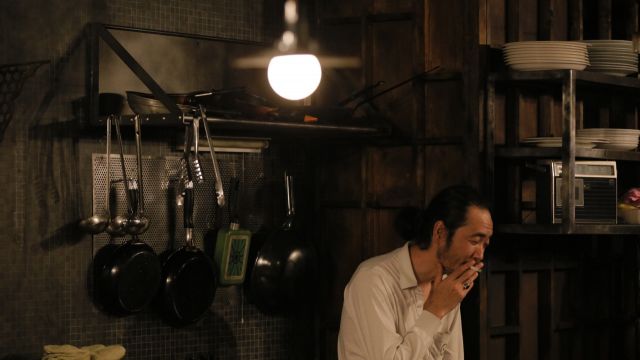The Dark Master
Adelaide’s weather is heating up, and the OzAsia Festival is winding down for 2019. In The Space, aromas from Japanese cooking permeate the theatre as The Dark Master unfolds and the onstage kitchen heats up with fiery blasts whenever alcohol is added to the cooking.
The Dark Master is based on an original story by Marei Karibu with direction byKurô Tanino of Niwa Gekidan Penino, a company he formed during his final year at university. Tanino originally trained as a psychiatrist and was also a keen painter and heavily influenced by Surrealism. His visual practice continues through his predilection for storyboarding his plays, as opposed to writing a fixed script. With such a rich history to draw from, I was somewhat disappointed with this production from the acclaimed director and company who have regularly shown work internationally.
The Space has a seriously raked seating system and, certainly at the very front of the audience, this made it difficult and at times neck-achingly uncomfortable to view the sur-titles – necessary, as the production is presented in Japanese language throughout.
At first glance, you are immediately struck by the detailed set, designed by Masaya Natsume to realistically portray a slightly down-at-heel eatery, Kitchen Nagashima in Osaka, complete with running water, cooking apparatus and range of utensils. In this atmosphere sits a man drinking and sighing, his back to the audience; there is also prodigious smoking at a later stage. With a slovenly, depressed appearance, he stumbles about with a pronounced limp and the first customer to enter is waved away rudely.
The tale is punctuated by several blackouts, accompanied by rousing Japanese music, one of which is a war song with lyrics projected on screen. There are allusions to Japanese / Chinese relations that have festered since the second Sino-Japanese war, 1937-1945. In fact, the slovenly chef informs his second customer that he has run the restaurant since that time. Although initially stating that he isn’t interested in talking, the chef eventually tells his outlandish riches to rags story “I had to do something and I liked cooking…” as he finally agrees to prepare a remarkable dish (Omurice) for the hungry young backpacker.
 From this point, the play proceeds, although at a tortuously slow pace. The main performers are quite adequate in their different roles but the interactions are forced rather than the actors allowing themselves to be in the moment and really listening. There are elements that approach Bouffon or farcical qualities but are not fully explored. A parade of bored minor characters appear but do little to liven the pace, more serving a fill-in purpose as film extras do.
From this point, the play proceeds, although at a tortuously slow pace. The main performers are quite adequate in their different roles but the interactions are forced rather than the actors allowing themselves to be in the moment and really listening. There are elements that approach Bouffon or farcical qualities but are not fully explored. A parade of bored minor characters appear but do little to liven the pace, more serving a fill-in purpose as film extras do.
The chef (addressed as ‘master’) inexplicably persuades the no-hoper backpacking customer to take over the restaurant. The newcomer’s alarm at this proposal is quashed as the chef proffers a minute earpiece and explains where the microphones are hidden - this is so that cooking and serving instructions can be discreetly given to the young man and he can in turn address the master in a series of humorous moments played for laughs, though only a small portion of the audience obliged. Subsequently, the master disappears ‘upstairs’ and is only heard by both young chef and audience through our own earpieces.
As the days pass-thirteen, then thirty three- the young man becomes a proficient cook, even dreaming about cooking, and the eatery is booming. It would seem the master upstairs is attempting to makeover this new recruit in his own image. Is this a sinister trap by some devilish persona or do we suspend disbelief and take the story at face value?
A Chinese customer/mobster confronts the young man on two occasions, possibly trying to acquire the thriving business, then beats him senseless. After the beating the new chef is left with a limp, exactly emulating the master’s limp. Additionally the master has been coercing the young man to take up drinking and smoking and even booked him a liaison with a favoured prostitute. The beatings and any sexual action all modestly take place ‘in the kitchen’ behind the dining bar so that it is only sound effects, above-the-waist physicality and dialogue that illuminate those scenes, apart from garish ‘mood’ lighting states for the romantic rendezvous.
Despite some powerful elements to play with, this production does not pull together as a whole and it was interesting to eavesdrop on the variety of comments as we left the theatre.
I questioned my take on the production, wondering if there were cultural nuances that I missed or that the language and translation was an obstacle. However, reflecting on the many foreign language theatre productions I have seen at past OzAsia and Adelaide Festivals, I firmly believe that excellent theatre can, and should, transcend language and deliver unquestioned engagement.
Lisa Lanzi
Photographer: Takashi Horikawa
Subscribe to our E-Newsletter, buy our latest print edition or find a Performing Arts book at Book Nook.

